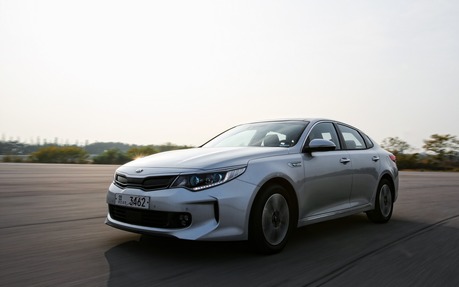2016 Kia Optima Hybrid And Optima PHEV: Big Leap Forward
Kia is feeling the pressure from ever-mounting fuel efficiency regulations as much as any other automaker, and like many of its peers it has decided that the path to appeasing those wielding the measuring stick at the EPA is to produce hybrid versions of its popular models. The 2016 Kia Optima Hybrid is the second-generation of the mid-size family car to receive a battery-assisted drivetrain, and the first to gain a plug-in hybrid electric vehicle (PHEV) model to sit alongside it in the showroom.
Based on the same bones as the equally-new gas-only 2016 Optima, the Hybrid and PHEV editions of the car maintain the styling swagger that the four-door was known for. More importantly, Kia has stepped up to smooth over some of the rougher elements of the original Optima Hybrid by completely revamping its drivetrain. It's a successful effort that transforms the battery-assisted sedan into a legitimate option for mainstream buyers.
New Motor, Bigger Battery, Happier Times
The 2016 Kia Optima Hybrid says good-bye to the 2.4-litre four-cylinder engine that previously took up residence between its front fenders and instead welcomes a direct-injected 2.0-litre engine that works together with a single electric motor (and a battery that's grown by 13%) to produce 193 horsepower. The latter sits where the torque converter normally would in the Optima Hybrid's six-speed automatic transmission, making it an unusual entry in a battery-assisted world populated almost exclusively by continuously-variable automatic designs. Fuel economy for the reconfigured Hybrid has risen 10 percent to 5.6 l /100 km combined.
The Optima PHEV is essentially the same mechanically, but with the added wrinkle of a much larger battery - almost six times larger, in fact, and with the ability to recharge its lithium-ion power pack via a wall socket (or, for faster 3-hour top-ups, a 240-volt charging station). In addition to returning 5.8 l/100 km in combined driving, the plug-in design also offers close to 50 kilometres of electric-only operation and a slight horsepower advantage (202 ponies in total)
Much, Much Smoother
Splitting time between both the 2016 Kia Optima Hybrid and the Optima PHEV in fierce Korean traffic outside of the capital city of Seoul revealed that the drivetrain makeover has worked wonders on the drivability of the sedan. Whereas the older battery-assisted Optima didn't process the hand-off between the electric motor and the intervention of the gas engine with anything resembling grace, the new edition offers seamless hybrid operation regardless of the situation, combined with natural and linear acceleration from its six-speed automatic gearbox. Power is sufficient to keep up with the flow of traffic, and the Optima Hybrid's handling and road manners are in keeping with segment rivals.
Unfortunately, due to the fact that the plug-in version of the Optima that I drove was a fairly early prototype I wasn't able to form a full impression of how it improved on the base Hybrid design. It was hit or miss as to whether I could keep the car in EV mode and cruise on just battery power alone, as the control software for the car was still a work in progress, and a few other features didn't seem to respond as one would expect in a production model. That being said, I'm happy to report that one Kia hybrid bugaboo - unpredictable braking from its regenerative system - has been banished by the automaker's engineering team.
Finally, The Complete Package
Eco-friendly or not, mid-size sedan shoppers (who are already reluctant to buy hybrids) aren't going to accept a car that asks them to trade comfort and practicality for sheer efficiency. The 2016 Kia Optima Hybrid has taken a big step forward in terms of matching competitors like the Ford Fusion Hybrid and the Toyota Camry Hybrid when it comes to providing a comfortable driving experience, and by relocating its lithium-ion battery it now delivers a much more reasonable amount of trunk space. The Optima Plug-In Hybrid's plus-size power pack might eat up a bit more room than its more affordable sibling, but the upshot is genuine electric-only driving (that can be maximized by the car's capability to charge the battery by using its gas engine as a generator).
It's a one-two punch that was missing from the Kia line-up until now, and while each of these vehicles may be more about crossing all the t's and dotting all the lowercase j's on the corporate average fuel economy paperwork than they are about meeting a pressing consumer need, they demonstrate just how serious Kia is about reducing the amount of fuel consumed by its entire fleet of automobiles by 25% over the course of the next four years. Kia is sending a signal, not just to customers but also other car companies, that its research and development team is more than capable of keeping up with the latest cutting edge trends in alternative fuel technologies. Message received.
| Test drive report | |
| Test model | 2016 Kia Optima |
|---|---|
| Trim level | Hybrid |
| Price range | N/A |
| Price as tested | N/A |
| Warranty (basic) | N/A |
| Warranty (powertrain) | N/A |
| Fuel economy (city/highway/observed) | N/A |
| Options | N/A |
| Competitive models | Buick Regal, Chevrolet Malibu, Chrysler 200, Dodge Avenger, Ford Fusion, Honda Accord, Hyundai Sonata, Mazda Mazda6, Nissan Altima, Subaru Legacy, Toyota Camry, Volkswagen CC, Volkswagen Passat |
| Strong points |
|
| Weak points |
|
